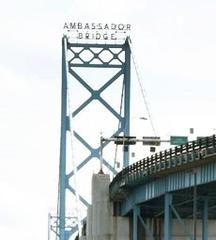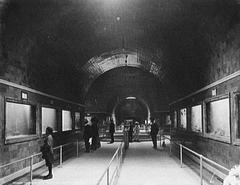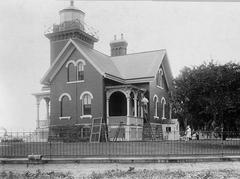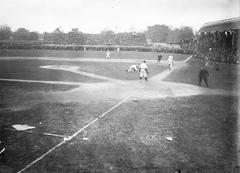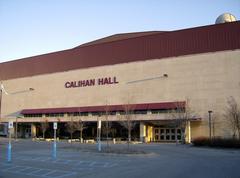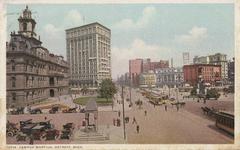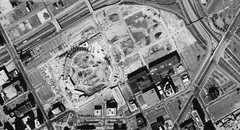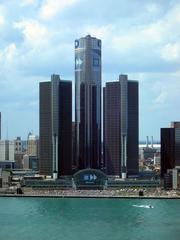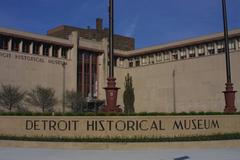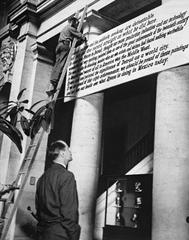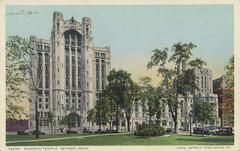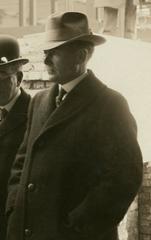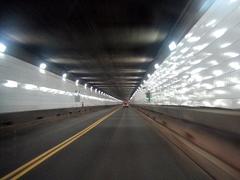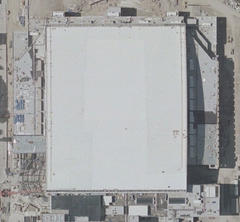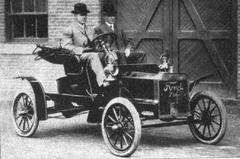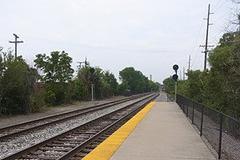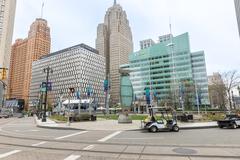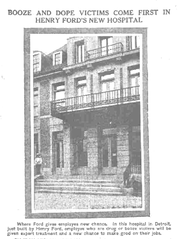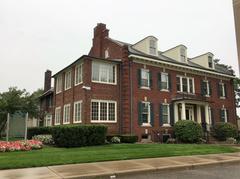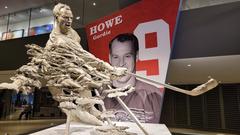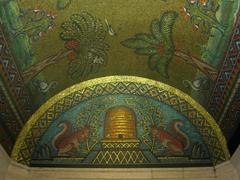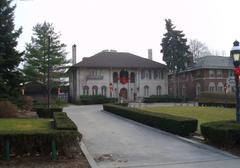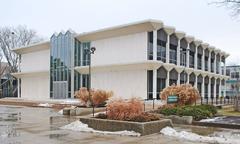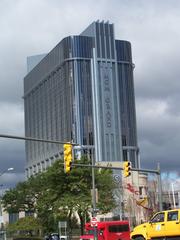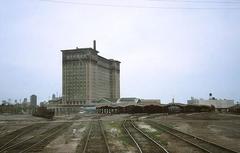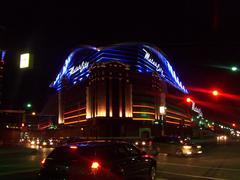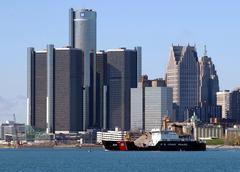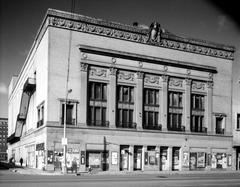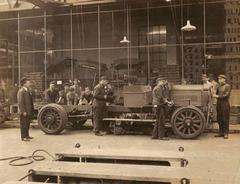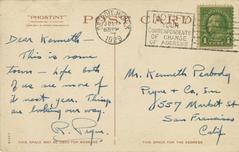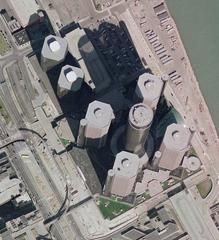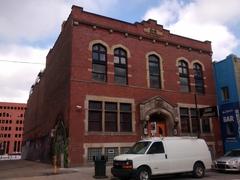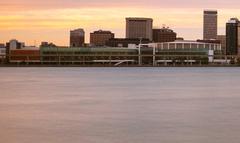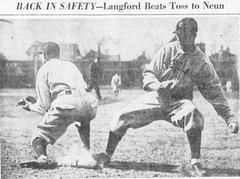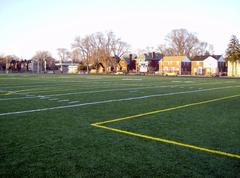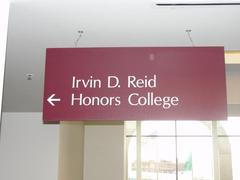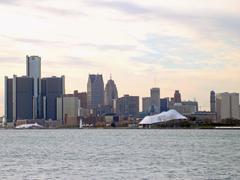
United Artists Theatre Building Detroit: Visiting Hours, Tickets, and Historical Information
Date: 04/07/2025
Introduction
The United Artists Theatre Building in Detroit stands as a testament to the city’s cinematic golden age and architectural ambition. Opened in 1928 and designed by renowned architect C. Howard Crane, this landmark originally featured a lavish Spanish-Gothic movie palace and an 18-story office tower. Commissioned by Hollywood legends Mary Pickford, Douglas Fairbanks, Charlie Chaplin, and D.W. Griffith, the building became a centerpiece of Detroit’s thriving Theater District, reflecting the city’s cultural and urban aspirations (Forgotten Detroit; DetroitYES).
Although the original auditorium was demolished in 2022 due to structural concerns, the adjacent office tower remains and is being redeveloped as The Residences @ 150 Bagley—a mixed-use complex that honors Detroit’s commitment to historic preservation and inclusive urban renewal (City of Detroit; Detroit Chamber). Today, while direct public access to the building is limited, visitors can explore the surrounding Grand Circus Park district and connect with Detroit’s rich theater history through nearby sites and virtual resources.
Table of Contents
- Origins and Construction
- Architectural Significance
- Early Years and Cultural Impact
- Decline and Attempts at Revival
- Recent History and Redevelopment
- Visiting Information: Hours, Tickets, and Accessibility
- Nearby Attractions
- Preservation, Community Impact, and Future Prospects
- Frequently Asked Questions (FAQ)
- Summary and Travel Tips
- References
Origins and Construction
The United Artists Theatre Building was conceived at the height of Detroit’s prosperity, embodying the optimism and grandeur of the 1920s. United Artists, led by industry icons Pickford, Fairbanks, Chaplin, and Griffith, selected Detroit for one of their flagship venues. C. Howard Crane’s design responded to the challenges of an irregular lot by combining an 18-story office tower with a 2,070-seat theater, the latter set at a 50-degree angle to Bagley Street for maximum street presence (Forgotten Detroit). The building’s opening in 1928 marked a milestone in Detroit’s architectural and entertainment history.
Architectural Significance
The building’s exterior exemplifies the Spanish-Gothic style, with a robust stone base, elegant arches, and, originally, a neon-lit marquee and an eight-story vertical sign. The office tower rose in a classic, boxy form above the ornate lower floors. Inside, the auditorium showcased intricate plasterwork, Indian maiden figures, and acoustical design elements, earning acclaim for its beauty and sound quality (Forgotten Detroit).
The theater shared decorative schemes with United Artists venues in Los Angeles and Chicago but featured unique adaptations for Detroit’s site. Its intimate scale made it ideal for reserved seating and exclusive premieres.
Early Years and Cultural Impact
Debuting with “Sadie Thompson” in 1928, the United Artists Theatre quickly became a cornerstone of Detroit’s entertainment scene. It was one of only two Detroit venues to premiere “Gone With the Wind” in 1939, and it hosted major Hollywood releases throughout the 1930s and 1940s. The building contributed to the lively Grand Circus Park area, then known as Detroit’s theater district (Forgotten Detroit; DetroitYES).
Decline and Attempts at Revival
The rise of television, suburban multiplexes, and population shifts led to a decline in downtown theater attendance. The United Artists Theatre closed in 1971, and its fixtures were auctioned off in 1975. The auditorium saw brief use by the Detroit Symphony Orchestra for recordings (1978–1984), appreciated for its acoustics. Meanwhile, the office tower underwent a modernizing remodel in the 1960s, but tenant losses continued, leading to full closure by 1984 (Forgotten Detroit).
The 1990s brought various, ultimately unsuccessful, revival attempts, including short-lived nightclubs and redevelopment plans. Ownership shifted from private investors to the City of Detroit, and finally to the Ilitch family, but no sustainable restoration materialized. Vandalism and neglect accelerated the building’s deterioration (Forgotten Detroit).
Recent History and Redevelopment
Demolition of the Theatre
After decades of vacancy and failed redevelopment attempts, the theater auditorium was demolished in late 2022 due to severe structural issues (Historic Detroit; Detroit Development Tracker). The site now serves as parking for the adjacent tower’s new residents.
The Residences @ 150 Bagley: Adaptive Reuse
The surviving United Artists office tower is undergoing a $75 million transformation into The Residences @ 150 Bagley, led by the Bagley Development Group in partnership with Olympia Development of Michigan. This project includes:
- 148 apartment units (20% designated as affordable housing)
- Approximately 10,000 sq. ft. of retail and dining space
- Dedicated residential parking on the former theater site
- Architectural restoration to preserve historic elements (City of Detroit; Detroit Chamber)
Construction began in 2022, with pre-leasing reported in 2024 and first residents expected by late 2024 (Detroit Development Tracker).
Visiting Information: Hours, Tickets, and Accessibility
- Current Status: The original theater is demolished and not accessible. The office tower, now The Residences @ 150 Bagley, is not open for public tours but will feature retail and dining spaces accessible to visitors upon completion.
- Visiting Hours and Tickets: There are no scheduled public tours or ticketed events inside the building. Access to retail spaces will be available during standard business hours once they open (Historic Detroit).
- Accessibility: Ground-floor retail and dining will be designed for accessibility. The surrounding sidewalks and public spaces are generally accessible.
- Parking: Resident-only parking is provided on the former theater site. Visitors should use nearby public garages or street parking.
- Public Transit: The site is accessible via the Detroit People Mover, QLINE streetcar, and several DDOT bus routes.
Nearby Attractions
Visitors to Grand Circus Park can immerse themselves in Detroit’s architectural and cultural wealth by visiting:
The neighborhood is known for its vibrant mix of theaters, sports venues, restaurants, and historic sites (Visit Detroit).
Preservation, Community Impact, and Future Prospects
The transformation of the United Artists Building is a major milestone in Detroit’s ongoing revitalization. Led by a local, Black-owned development group, the project aligns with city priorities for equitable and inclusive redevelopment. It serves as a model for adaptive reuse of historic buildings and reactivates a key landmark within the broader District Detroit plan (City of Detroit; Detroit Chamber).
Advocacy groups continue to promote Detroit’s heritage, offering guided walking tours and public programming to foster community engagement and appreciation for the city’s architectural legacy (Detroit Historical Society).
Frequently Asked Questions (FAQ)
Q: Is the United Artists Theatre open to visitors?
A: No, the theater auditorium was demolished in 2022. The office tower is being redeveloped and is not open for tours.
Q: Are there guided tours available?
A: There are no regular tours of the building, but walking tours of the Grand Circus Park theater district may include historical context about the United Artists Theatre.
Q: How can I access the site?
A: The building’s exterior can be viewed from the street. Retail spaces will be open to the public after redevelopment.
Q: Where can I park?
A: Use nearby public parking garages or street parking; resident parking is not available to visitors.
Q: What other historic sites are nearby?
A: The Fox Theatre, Detroit Opera House, Guardian Building, and Comerica Park are all within walking distance.
Summary and Travel Tips
The United Artists Theatre Building embodies Detroit’s enduring spirit—once a glamorous movie palace, now a symbol of renewal through its adaptive reuse. While the original theater is gone, the office tower’s revitalization provides new opportunities for community living and commerce. Visitors can enjoy the area’s historic ambiance, explore nearby landmarks, and engage with Detroit’s vibrant past and present (Forgotten Detroit; DetroitYES; Detroit Historical Society).
Travel Tip:
For the fullest experience, combine a walk through Grand Circus Park with visits to neighboring theaters and museums. Leverage virtual tours and photo archives online for a deeper historical perspective—especially through resources like Forgotten Detroit.
References
- United Artists Theatre Detroit: History, Visiting Hours, Tickets & Cultural Significance, 2025, Forgotten Detroit (http://www.forgottendetroit.com/uat/history.html)
- United Artists Theatre Detroit: Visiting Hours, Tickets & Architectural History, 2025 (https://www.detroithistorical.org/)
- United Artists Theatre Building Detroit: History, Visiting Hours & Tickets, 2025, DetroitYES (https://www.detroityes.com/news/070705/601pics/201.htm)
- United Artists Theatre Detroit: History, Redevelopment, and Visitor Information, 2025, City of Detroit (https://detroitmi.gov/news/bagley-development-group-begins-75m-transformation-historic-united-artists-building-residences-150)
- Historic Detroit: United Artists Theatre Building, 2025 (https://historicdetroit.org/buildings/united-artists-theatre)
- Detroit Chamber: Black-led Development Group Kicks Off $75 Million Renovation, 2025 (https://www.detroitchamber.com/black-led-development-group-kicks-off-75-million-renovation-of-united-artists-building/)
- Detroit Development Tracker: United Artists Building Theater Project, 2025 (https://development-tracker.outliermedia.org/projects/united-artists-building-theater)

